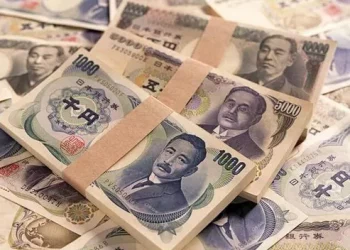Mumbai, India – In Monday’s trading session, the Indian Rupee (INR) experienced a decline against the US Dollar (USD) as oil companies and other importers increased their demand for the American currency. The hawkish sentiments expressed by Federal Reserve officials regarding maintaining higher policy rates for an extended period may limit significant gains for the INR. However, potential intervention by the Reserve Bank of India (RBI) is anticipated to mitigate excessive volatility.
According to minutes from the latest RBI policy meeting, the Monetary Policy Committee (MPC) acknowledged the resilience of the Indian economy on the growth front. Nevertheless, uncertainties surrounding food inflation, volatility, and geopolitical influences could constrain the upward movement of the INR.
Investors are closely monitoring upcoming economic indicators, including the US Gross Domestic Product Annualized for the fourth quarter (Q4) on Wednesday and the Core Personal Consumption Expenditures Price Index (Core PCE) on Thursday. Domestically, Thursday will see the release of India’s GDP annual growth figures and Federal Fiscal Deficit, while Friday will unveil the Indian S&P Global Manufacturing PMI for February.
In recent developments, India’s foreign exchange reserves experienced a consecutive two-week decline, reaching a two-month low of $616.10 billion on February 16, according to the RBI. The central bank has revised its growth forecast for the Indian economy to 7% for the current fiscal year, reflecting an increase from the previous estimate of 6.5%. The RBI’s Monetary Policy Committee emphasizes the need for caution amid uncertainties while maintaining optimism about growth.
The Indian economy, which exhibited a four-month high growth in January, continued its expansion in February, marked by acceleration in both the manufacturing and services sectors. Meanwhile, Federal Reserve Governor Christopher Waller advised delaying interest rate cuts by a few more months to observe additional evidence of inflation data.
Technical Analysis: Indian Rupee Struggles Within a Defined Range
In the technical realm, the Indian Rupee remains constrained within the 82.70–83.20 range in the longer term. The USD/INR pair sustains a bearish short-term outlook, trading below the critical 100-day Exponential Moving Average (EMA) on the daily chart. Additionally, the 14-day Relative Strength Index (RSI) below the 50.0 midline indicates a downside bias.
The initial support level for the pair lies at the lower limit of the descending trend channel at 82.70. A decisive break below this level could pave the way for further declines, targeting the next downside levels at 82.45 (August 23 low) and 82.25 (June 1 low).
Conversely, immediate resistance is observed at the psychological round mark and the 100-day EMA at 83.00. A sustained uptrend could propel USD/INR towards testing the upper boundary of the descending trend channel at 83.20, aiming for a high of January 2 at 83.35, and potentially reaching the round figure at 84.00.


























